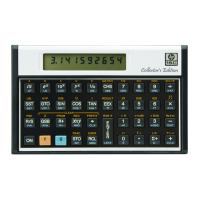42 Section 3: The Memory Stack, LAST X, and Data Storage
*
1,150.0000
Population at the end of day 1.
*
1,322.5000
Day 2.
*
1,520.8750
Day 3.
*
1,749.0063
Day 4.
Storage Register Operations
When numbers are stored or recalled, they are copied between the display
(X-register) and the data storage registers. At “power-up” (initial turn-on
or Continuous Memory reset) the HP 15c has 21 directly accessible
storage registers: R
0
through R
9
, R
.0
through R
.9
, and the Index register (R
I
)
(see the diagram of the registers on page 76). Six registers, R
2
to R
7
, are
also used for statistics calculations.
The number of available data storage registers can be increased or
decreased. The m
function, which is used to reallocate registers in
calculator memory, is discussed in Appendix C, Memory Allocation. The
lowest-numbered registers are the last to be deallocated from data
storage, therefore it is wisest to store data in the lowest-numbered
registers available.
Storing and Recalling Numbers
O (store). When followed by a storage register address (0 through 9
or .0 through .9
*
), this function copies a number from the display (X-
register) into the specified data storage register. It will replace any
existing contents of that register.
l
(recall). Similarly, you can recall data from a particular register into
the display by pressing l followed by the register address. This brings
a copy of the desired data into the display; the contents of the storage
register remain unaltered.
X (X exchange). Followed by 0 through .9,
*
this function exchanges the
contents of the X-register and the addressed data storage register. This
is useful to view storage registers without disturbing the stack.
*
All storage register operations can also be performed with the Index register (using V
or %), which is covered in Section 10, and with matrices, Section 12.

